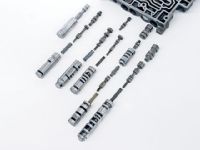
Shift Valves-Automatic Transmissions
All automatic transmissions have a brain of sorts. We call this part a valve body. Reason being is there are plenty of ” shift valves” in a valve body that control hydraulic pressure by overcoming the force of a return spring, allowing the fluid to flow into the correct passage ways to perform it’s tasks.
The manual valve is what the shifter lever hooks up to. Depending on which gear is selected, the manual valve feeds hydraulic circuits that cause certain gear ratios. For instance, if the shift lever is in third gear, it feeds a circuit that shifts from 1st to second to third gear, yet prevents overdrive from engaging.
Shift valves allow hydraulic pressure to the clutch drums and band apply mechanisms to engage each gear. The valve body of the transmission contains the shift valves. The shift valve determines when to shift from one gear to the next. For instance, the 1 to 2 shift valve determines when to shift from first to second gear. The shift valve is pressurized with fluid from the governor on one side, and the throttle valve on the other. They are supplied with fluid by the pump, and they route that fluid to one of two circuits to control which gear the car runs in.
The shift valve will delay a shift if the car is accelerating quickly. If the car accelerates gently, the shift will occur at a lower speed. Let’s discuss what happens when the car accelerates gently.
As car speed increases, the pressure from the governor builds. This forces the shift valve over until the first gear circuit is closed, and the second gear circuit opens. Since the car is accelerating at light throttle, the throttle valve does not apply much pressure against the shift valve.
When the car accelerates quickly, the throttle valve applies more pressure against the shift valve spring. This means that the pressure from the governor has to be higher (and the vehicle speed will be faster) before the shift valve overcomes the springs force to engage second gear.
Each shift valve responds to a particular pressure range; so when the car is going faster, the 2-to-3 shift valve will take over, because the pressure from the governor is high enough to trigger that valve.
Shift valves can wear out. When a valve strokes back and forth in it’s bore for over 100,000 miles, it is very possible to experience wear in the bore, valve or both, causing shift problems. With this in mind, every rebuilt transmission has the valve body visually examined by a human before we put it on a valve body tester to insure your success.
Want to choose the best transmissions for sale? Call 866-320-1182 and speak with one of our representatives about why our transmissions are in your best interests, all in terms you will understand. GotTransmissions.com.


